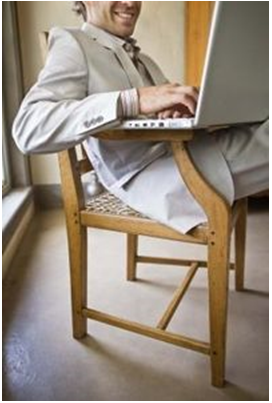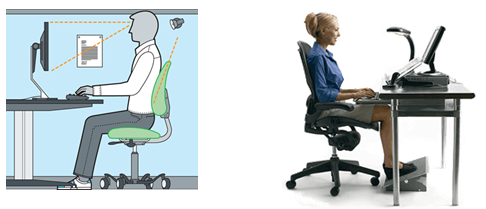As we have moved from the age of our grandfathers and grandmothers doing manual tasks, the technological age has created a workforce of people sitting 8-10 hours a day. The CHAIR has become the culprit where what we sit in, reflects our discomforts.
80% of the American workforce sits at a desk
Sit as they drive to work – on a train, on the subway or when flying
Sit at their meals
Sit at a seminar
Sit and watch television or read
The medical expenditures for RMI’s amounts to billions of dollars annually!
Sitting has become a national pastime. The body’s posture is molding to what ever you sit in – good or bad. Musculoskeletal disorders from sitting encompass neck and back pain, leg cramps, eye strain, abdominal pain, breathing disorders, symptoms of numbness and tingling, and repetition after repetition (RMIs), weeks, months and years has a cumulative effect on the posture of the body.
Any muscle discomfort adds stress to the physical and emotional body. Poor posture such as slumping with rounded shoulders stretches ligaments, tendons and distorts muscles that extend to all 600 + muscles. It impedes nerve flow and circulation, which results in symptoms of pain, spasms, cramps, loss of feeling, increased tension, numbness, tingling and loss of grip strength.
We all do this after sitting for long periods – we shift our weight in the seat. Our skin and muscles while sitting tend to flatten out and the skeletal structure, the pelvis and buttocks, presses into the muscles. Any fat you have and the muscles move out of the way, eventually leaving the skin as the last barrier between you and the hard surface of the seat pad.
As we shift our weight, the skin sustains high pressure thus reducing blood flow. The longer you sit, the more muscle tissue moves away from the bone increasing pressure on the skin and bone. The first symptom you may notice is a burning in your buttocks, then achy legs and calves, upper back wanting to stretch more often, back pain, neck strain and more. If you do not get up and move about and the burning persists, the skin begins to die and it is akin to an eventual bed sore.
***The word here is to get up every hour and move, stretch and drink water to rehydrate your muscles.
A good chair will give you good posture. It has to be adjusted correctly to fit your body. It can do wonders to a person’s productivity, focus and concentration and emotional well being.
Things to remember: Ergonomics is a science and no two bodies are the same. It is necessary that you adjust the chair to fit your size, height, and breath and to make sure that you can sit comfortably without those nagging symptoms.
At ERGOhealthy, we work to help you to increase your productivity and emotional wellbeing.
***Next time I will talk about how to adjust the chair.
Kate Montgomery is an ERGOhealthy Coach
www.ergohealthy.com
Resource: ergoteacher.com/scienceofsittin





